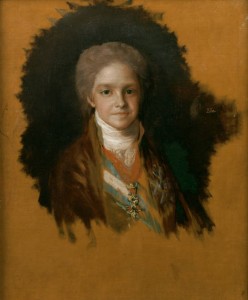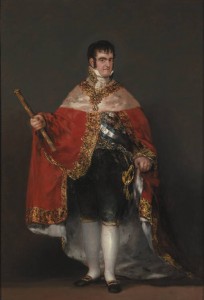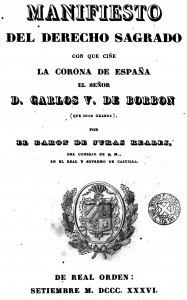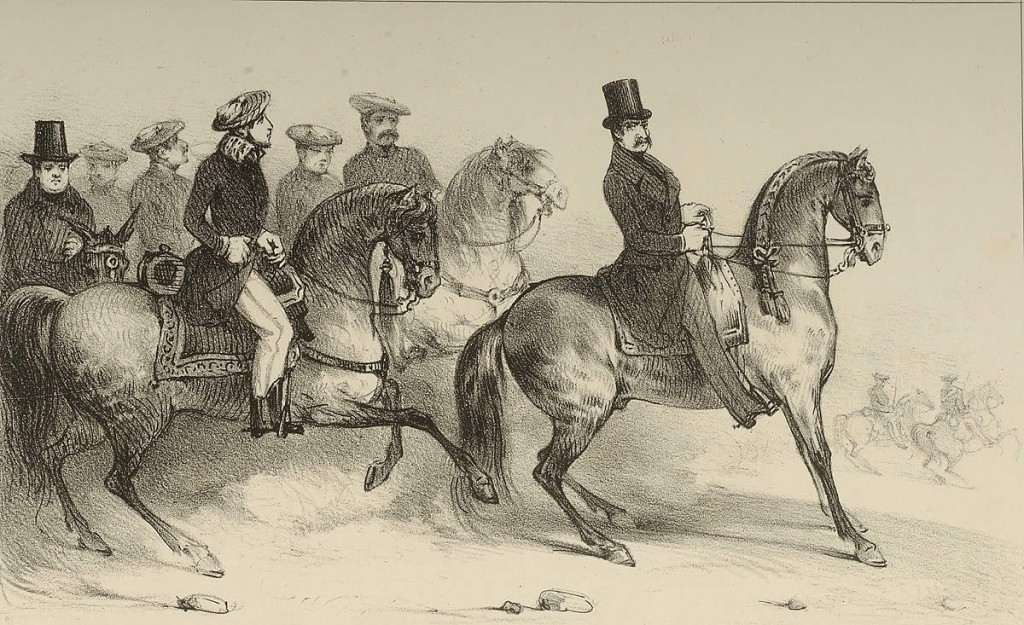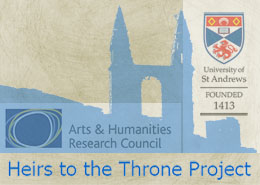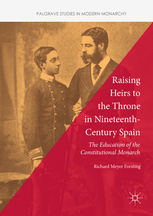More royalist than the King, more Catholic than the Pope
Richard Meyer Forsting
When Don Carlos was born on 29 March 1788, his grandfather Charles III was delighted to have another male grandchild who would be able to guarantee the succession. Partly this was due to the feeble health of Carlos’s elder brother, the future Ferdinand VII. It was only logical to prepare. Almost from the outset Don Carlos was groomed as if he was in fact the heir to the throne. Upon his brother’s accession to the throne in 1814 he was officially instigated as Prince of Asturias and would remain the heir apparent until 1830. Throughout his life Don Carlos would distinguish himself by his absolutist conception of monarchy, his deeply rooted religiosity and extreme loyalty to his brother. During the Liberal Triennium (1820-23) the radical liberal paper El Zurriago in its typically mocking style described Don Carlos as “more royalist than the King, more Catholic than the Pope”. Religion indeed formed a key element in his political thought and informed all his actions in the political, public and private sphere. His relation with the Catholic Church, one of the most powerful institutions in nineteenth-century Spain, was not linear but his religious sentiment was of decisive importance in his decision-making.
The roots of this piousness lie in childhood education. His parents, Charles IV and Louisa Maria of Parma, surrounded their children with ecclesiastical teachers and firmly grounded them in a religious setting. Among the teachers of the Infantes were some of the leading religious scholars of Spain, such as Felipe Scio de San Miguel (1738-1796) and Fernando de San Antonio Scio (1756-1806); both had been extensively experienced educators even before they took up their palace posts. Religion was not the only subject on the curriculum of the young princes. Don Carlos was educated in military history by the distinguished instructor and brigadier Don Vicente Maturana and received lessons in art from the court painter Antonio Carnicero. The curriculum was completed with lessons in modern and classical languages, horsemanship, dance, and court etiquette.
Juan Arzadun’s description of the princely education as a ‘regime of the seminar’ is influenced by the negative image that was posthumously painted of Ferdinand VII and his brother. There is no doubt, however, that the spiritual education of the princes received special attention. Catholicism was still seen as the most solid foundation sustaining the unity of Spain and its monarchy. The historical events that had shaped Spain, such as the Reconquista, the union of Aragon and Castille and the discovery of America could hardly be understood without a reference to religion and the Catholic Church. Don Carlos readily absorbed Catholic dogma through popular and historic catechisms, such as that written by Abbé Claude Fleury (1640-1723). His teachers instilled in him the idea that good government was based exclusively on the application of Catholic principles. While Ferdinand VII had received a similar upbringing he did not show the same religious fervour as his brother. Early nineteenth century sketches of Don Carlos’s life are filled with attributions of a deep morality, evangelical charity and Christian rectitude. They describe him as a true man of virtue. At 11 years old the daily routine of Don Carlos involved mass, the praying of the rosary and confession. This deep-seated religiosity is reflected in his personal library. Antonio Manuel Moral Roncal, arguing that libraries reflect the ideological preoccupations of their owners, has shown that religious works dominated Don Carlos’s book collection. Despite having a similar upbringing, Ferdinand’s library shows more of an interest in history and geography. Religious teaching seems to have had a much deeper impact on Don Carlos than on his brother.
Nevertheless the two brothers were close and among other things shared their dislike of their parents’ court favourite, Manuel Godoy. From an early stage the two princes were very close and remained so for most of their lives. Goya’s family portrait has sometimes been interpreted as foreshadowing the brotherly conflict that erupted in the last three years of Ferdinand’s reign. Looking at the portrait it is difficult to find these signs without applying the benefit of hindsight. Instead Don Carlos, in agreement with his religious principles, was developing an intense and unswerving loyalty to his older sibling, who to him was anointed by God to become king.
By the beginning of the nineteenth century, the family idyll had been severely disturbed by court rivalries which pitted Ferdinand against his parents and Godoy. The position Don Carlos took in this infighting is not entirely clear but it is believed that he sided with his older brother. However the dispute over the crown was ultimately settled from outside Spain. Napoleon Bonaparte made his brother Joseph the new king of Spain and banished the Bourbons into exile in France. Under the close supervision of Talleyrand in his Chateau at Valencay, the religious devotion of Don Carlos intensified further; the Catholic faith helped him to cope with feelings of displacement and the disgrace of exile. He once more filled his private library at Valencay with catechisms, hagiographies of saints and other religious tracts.

The family of Charles IV as painted by Goya. On the very left is Don Carlos, to his right and in front of him stands Ferdinand.
It was only six years later that Don Carlos returned to Spain at his brother’s side, now king of Spain after his father’s abdication. The return of the king put an end to liberal hopes of reform as expressed in the 1812 Cadiz constitution. Instead Ferdinand VII aimed to restore the absolutist monarchy and its traditions with full force. The theocratic ideology of Don Carlos led him to support his brother fully, in particular in rolling back measures curbing the power of the Church. While Charles IV had followed the example of his father, Charles III, of delegating very little responsibility to his immediate family, Ferdinand VII allowed Don Carlos to be heavily involved in politics. Although one major factor was certainly that Ferdinand had not produced an heir, one should not underestimate the bond of affection and mutual trust that existed between the two. Thus Don Carlos had a seat on the Council of State and even presided over it when his brother was absent. He was also in charge of the Junta por la Reconquista de las Americas whose task it was to organise the subjection of Spain’s rebellious overseas territories. The term Reconquista was traditionally associated with the expulsion of the Moors from Spain in the Middle Ages, which had guaranteed the predominance of Christianity on the Peninsula. The invocation of the Reconquista is not only a demonstration of the historical importance the Crown attached to the American territories but also of the religious significance of the colonial project. Don Carlos appears to have been a firm believer in Spain’s sacred duty to rule over and uphold the Catholic religion in the Americas. Later on, when much of the overseas empire seemed irredeemably lost, Don Carlos took a special interest in the campaigns against Berber piracy. Stopping Muslims from capturing Spanish men and goods was to Don Carlos a natural extension of the principles that had motivated the expulsion of the Moors during the Reconquista.
The trust Ferdinand placed in Don Carlos was rewarded by the latters complete devotion to his official responsibilities and to the monarch personally. As Prince of Asturias Don Carlos lived in the royal palace of Madrid and reported almost daily to the king. When Ferdinand was absent, Don Carlos kept his brother informed by writing him detailed letters with reports and suggestions. During the Liberal Triennium Don Carlos’s loyalty was put to the test. Despite his revulsion at the liberal reforms and the anti-religious rhetoric of the government, there is no evidence that he swerved in his loyalty to his brother. According to some contemporary newspapers he would have had ample opportunity to further his own ambitions; as early as May 1821 there were reports of the first ‘vivas’ for Charles V. The radical El Zurriago even urged Ferdinand to rid himself of his brother’s influence, while ultra-Catholic and royalist opinion was looking to Don Carlos in case Ferdinand’s governments would continue on a course of liberal reform. As Antonio Pirala has put it “Don Carlos came to be seen by his partisans as one of the most complete princes of Christianity”. While this meant that intrigues were hatched against Ferdinand in support of his brother’s ascension to the throne, evidence and the character of Don Carlos equally suggest that he never authorised these movements. After the absolute monarchy was re-instated, Ferdinand continued rewarding the loyalty of his brother. Don Carlos once again had a busy schedule, meeting ministers, ambassadors and generals, who thus acknowledged his influence at court. The concession of the honours of Infantes of Spain to the sons of Don Carlos, usually reserved for the sons of the king, are another demonstration of the close bond between the king and his brother’s family. When the Supreme Junta of the Cavalry, which had a similar standing to the War Council, was re-established in 1829, Don Carlos was put at its head. The resulting daily contact with the military establishment allowed him to forge strong bonds with the high command and favoured his prestige among the armed forces. This would be an important factor in attracting leading generals to his cause after the death of his brother.
The area that mattered most to Don Carlos during his time as heir remained always the Church. As soon as he returned to Spain Don Carlos publicly demonstrated his pious devotion and traditional religiosity. As mentioned before his strong beliefs were reinforced by the experience of exile; his religious devotion was to come to the fore during his time as heir apparent. To him the Catholic faith was not only a system of moral values to be followed but also an ideological instrument in the fight against the advance of revolution and liberalism. His conservative Catholicism informed his beliefs on the nature of monarchy – he was always a firm believer in the divine right and providence of kingship. A constitution restricting the actions of the monarchy was hence completely antithetical to him. Furthermore Don Carlos was convinced that the destiny of the monarchy and the Catholic Church were closely linked. The two institutions should aid and support each other against the impeding onslaught of liberal and atheistic thought. This conception of state-Church relations hawked back to the times of Felipe II; his father and grandfathers had instead sought to limit the influence of the church in public affairs. Don Carlos was a fervent supporter of the ecclesiastical policies of the restoration of 1814, which abolished anti-clerical legislation, returned church property previously expropriated and re-established the Inquisition. While other areas, such as the military and the economy, did not experience a complete return to the status quo ante, the regime almost completely restored the Church to its old standing; a development Don Carlos could not have been happier with. However, after the Liberal Triennium he was pragmatic enough to realise that another full restoration of the privileges of the Church was not possible due to the current financial state of Spain and the unpopularity of the Inquisition. Throughout his time as heir Don Carlos maintained a particularly close relationship with the Jesuit order. Thanks to a letter asking for his brother’s consent to his attendance we know that in 1816 he took part in the opening of a Jesuit college in Madrid. Later on he was involved in the re-establishment of the Order of San Ignacio and the building of a new Jesuit seminary. He frequently visited seminaries, presided over exams in Jesuit colleges and attended mass and religious celebrations, urging his older brother to do the same on his travels. His affinities for the Jesuits went so far that one provincial priest suggested investing him with the title of Protector de la orden de Jesús. The Jesuits were keen to nurture this bond with the royal family due to the opposition they often encountered from other ecclesiastical and secular authorities. Alonso Tejada has argued that they invested their hopes and ambitions primarily in Don Carlos, who seemed almost certain to succeed to the throne before the birth of Isabel II in 1830 (Ferdinand had remained childless in his previous three marriages). His proximity to the order is also exemplified in his choice of Mariano Puyol, a Jesuit priest, as teacher for his two eldest sons. The teacher who replaced him and the personal confessor of Don Carlos and his wife were also Jesuits.
His commitment to Catholicism was no mere window-dressing, as demonstrated by his private behaviour. It was said that Ferdinand had to urge his brother to give up on the celibate life that he had planned for, and marry Maria of Portugal. Once married he would, however, present himself inseparable from his wife. He was certainly no womaniser and did not keep any mistresses, as opposed to his brother and many previous and future Spanish kings. Don Carlos took the sacred commitment of Catholic matrimony very seriously. He furthermore made it his private mission to use his influence over his brother as best he could to ensure there was a harmonious relationship between monarchy and Church. In his private correspondence he urged his brother to attend religious ceremonies, visit convents and monasteries and pray in front of important relics. Even though some proposals had little chance of success Carlos used his influence to defend the Church: He supported the separation of the oath sworn by priests to the pope and that sworn to the king despite the opposition of his brother and his advisers to this measure. The proposal ultimately failed because there were strong forces advocating against it. Don Carlos carefully avoided a head on confrontation over such issues; he was prudent enough to know that clashing with his brother and his advisers would affect his position and hence his ability to defend church interests at court. In addition, he used his family’s private rents to build a discrete church and convent in Orihuela (Alicante) aimed at providing a haven for religious women who had been displaced by the Napoleonic wars and revolutionary expropriations.
The publication of the 1830 Pragmatic Sanction removed Salic law and allowed for Ferdinand’s daughter Isabella to eventually succeed, thus replacing Don Carlos as heir to the throne. This was the end of the largely harmonious relationship between Ferdinand and his brother. While Don Carlos did not actively intrigue against his brother, supporters of his cause, in particular the clergy defended his rights against that of Isabel. Don Carlos did not take any immediate action but was sent away from court and later into Portuguese exile. After the death of his brother in 1833, Don Carlos proclaimed himself Carlos V, thus initiating what was to become the Carlist War. His opponents interpreted this as an expression of personal ambition and fundamental opposition to reform. However, Antonio Manuel Moral Roncal has argued that it was actually Don Carlos’ religious beliefs that motivated his rebellion against Isabel and her supporters. Don Carlos based his claim to the throne on the belief that the right to rule was given to him by God and thus could not be revoked by the Cortes and the king’s advisers. Once these questions got entangled with the political conflict between liberal reformers and conservative royalists they caused the perfect storm that led to the following bloody and destructive seven-year civil war. During this conflict Don Carlos sought to underline the connection between his cause and that of the Catholic Church. He invoked the Dios de las batallas in his military proclamations and declared the Virgen de los Dolores to be a Generalísima of his armies. While he did not re-institute the Inquisition in the territories he controlled, he did pursue the closer connection between Church and state that he desired so much.
Don Carlos’ respect for the Church never diminished and ultimately even played a decisive role in his decision to abdicate. He was unwilling to give up his right to the throne after he had been militarily defeated, holding on to the belief that the crown of Spain was his divine right. However, he continued to solicit the advice of the Pope and it was only when Gregory XVI recommended he relinquish his claim that he abdicated in favour of his son in May 1845.
Suggested Reading:
Moral Roncal, Antonio Manuel, ‘La Impronta Religiosa En La Vida Del Infante Don Carlos María Isidro de Borbón’, Hispania sacra, 53 (2001), 111–32
Moral Roncal, Antonio Manuel, Carlos V de Borbón, 1788-1855 (Madrid: Actas Editorial, 1999)
Seco Serrano, Carlos, ‘Don Carlos Y El Carlismo’, Revista de la Universidad de Madrid, 4 (1955)
Wilhelmsen, Alexandra, «The Political Thought of the Pretender Don Carlos», en VV. AA., The Consortium on Revolutionary Europe 1750-1850, Athens, 1985
Extensive reading list on Cervantes Virtual: http://www.cervantesvirtual.com/bib/portal/reyes_y_reinas/include/pertenecias_carlistasb862.html?pagina=carlistas3.jsp


